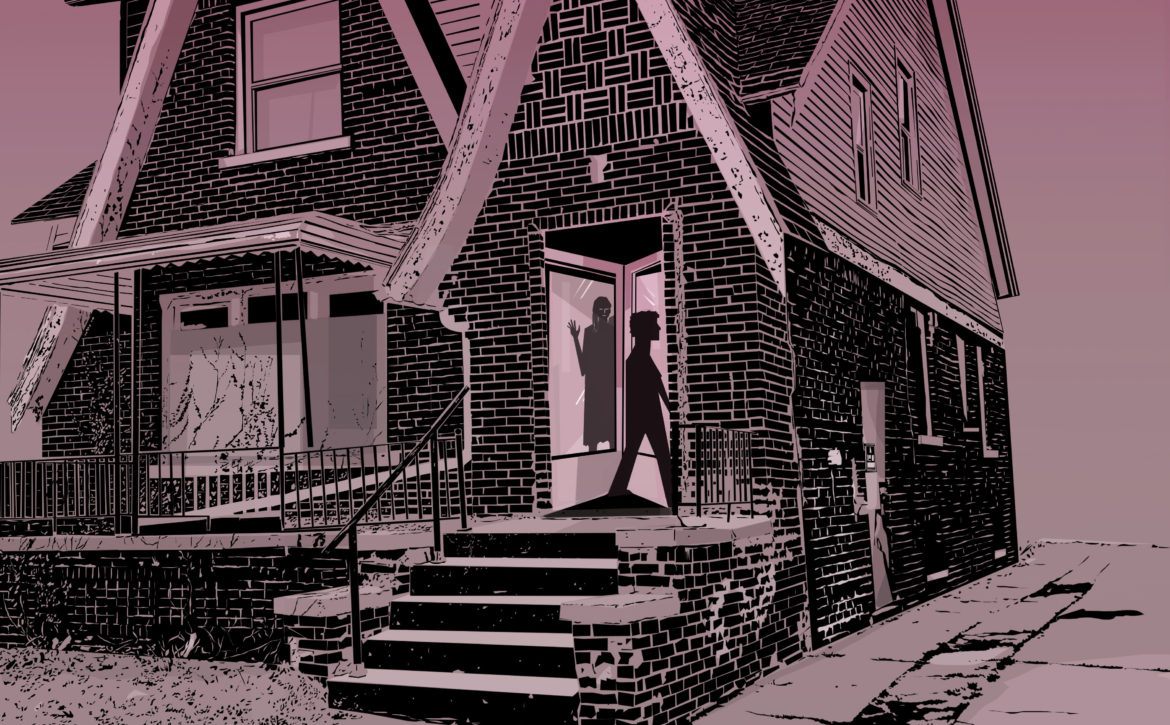
Living Through Detroit’s Perpetual Housing Crisis
My family moved to Detroit in 1998, when I was seven years old, and to the house where we live now on the west side of the city in 2005. Since then, the house to our right has seen a rotating cast of occupants. The house is identical to ours. It’s a single-family home with two floors, five bedrooms, and two bathrooms. There’s a large window facing the street from the living room, and the top seems to be made to look like several mountain peaks. When I was young, before I had any real knowledge of the racism and poverty that had created its own map of the city, I just knew that every few years our neighbors would move out and new ones would come in. One year, it was a mother, an aunt, and four daughters. Sometimes boyfriends were snuck in through the side door, but I don’t recall ever seeing a man there for more than a visit with this house of women. The mother was funny and personable, at least toward me. She would sit on the porch and joke that she was proud of my journey through college because it would make me an educated man—perfect for one of her daughters. I saw the U-haul trucks coming in the days when they were leaving, but I wasn’t there when they left for the last time. A family of four came next: a mother, father, and two children, a girl and a boy. I barely saw the mother and the kids since their schedules clashed with mine—they left for school and work much earlier than I would leave for my classes, and I came back late, when they were already inside for the day—but at night I could hear them from their house, talking about the shows they were watching, or the mother yelling at the children to settle down. I saw the father more often. In the mornings, when I left the house, he would be outside standing on the porch smoking a cigarette. He was usually looking out into the sky in front of him. We would exchange greetings and small talk, and then he would go back to his gazing into the distance as I drove off. We also saw each other at night. He would again be standing outside when I left to see friends, and I would still see him outside when I returned. Our small talk happened in the mornings and in the nights. This routine must have gone on for years. One night I came back and sat in the car for an extra hour before going inside, for what I imagine was my normal sadness back then. He stood outside that extra hour. When we said our goodnights, he joked that I made him wait outside longer than usual. The next time I saw him, I asked him what he meant by it—me making him wait longer—and he said that on the nights when I went out, he waited until I returned before going back inside. It wasn’t a hassle for him, he said, since it fit well with his habit of standing outside and smoking. After the family moved out, the rate of change of people living in the house increased. I got older and with the cannibalization of life by work and stresses of adulthood, it became harder to know each new neighbor before they left. Life was moving fast, and the neighbors kept changing. The story of my block is the story of a lot of blocks in Detroit, a majority Black city where so many Black Detroiters still find it nearly impossible to rent, let alone own a home. It took a while for me to really connect them, but the story of the house next to ours is a story of the same great injustice that’s burdened Black Detroiters since they first arrived. A friend of mine once said that it’s possible to understand America’s violence toward Black people by looking at Detroit. The city was code-named “Midnight” on the Underground Railroad and was a critical juncture to potential freedom for fleeing enslaved people. The Detroit River is a small separation between the United States and Canada, which abolished slavery through the British Imperial Act of 1833. That was also coincidentally the year of the earliest recorded race riot in the city: the Blackburn riots. The riots started after Black Detroiters fought against the Wayne County sheriff over the jailing of two escaped enslaved persons, Thornton and Lucie Blackburn—physically wrestling Lucie away from the sheriff—which then led to an uprising. In the aftermath, white Detroiters demanded that their Black counterparts have their movements restricted, including being given a 9 p.m. curfew. The consequences of the riot extended far beyond the city. “When the couple sought refuge in Upper Canada,” wrote Canadian historian Karolyn Smardz Frost in I’ve Got a Home in Glory Land, “a sharp diplomatic altercation between Michigan’s Territorial Governor and the British colonial government of Upper Canada over their extradition had a very significant result: the formulation of British North America’s first, articulated legal rationale for harboring fugitive slaves. In fact, it was the Blackburn case that formally established Canada as the main terminus of the Underground Railroad.” Detroit still has monuments of and to that struggle to freedom from slavery. At the Second Baptist Church, three stories of brick with gothic accents, one can still walk down the stairs and see the basement room where over 5,000 enslaved people were housed, hidden, and protected on their journey to Canada. Slavery ended, and oppression continued in other ways. Because of the lasting structures and communities created by prominent Black families, and the opportunities of work, Detroit went from a juncture of freedom to a city where Black people could attempt to build a dignified life. Yet that desire has always been met not only with visceral racial violence but oppression through more subtle means. Housing discrimination has been one of the most enduring ways of upholding the racial caste system. Black people have lived in Detroit for a very long time, but it has been in spite of the structures set to make their existence as difficult and as burdened as possible. Detroit is going through a housing crisis now, with gentrification and rising rental prices, but it’s more fair to say that Detroit has always had a housing crisis—at least when it comes to allowing Black people to live equitably. In 2016 the NAACP Legal Defense and Education Fund, along with the ACLU of Michigan and Covington & Burling LLP, filed a class action lawsuit against Wayne County to end racially discriminatory tax foreclosures in Detroit, and in their report, they listed out the history of housing discrimination that’s been ingrained in Detroit history.From the 1920s until the 1960s, even after the Supreme Court deemed it unconstitutional in 1948, property deeds in the city restricted home ownership to White, American-born Christians. The 1930s then saw federal mortgage subsidies give birth to redlining and the denial of subsidized mortgages in Black neighborhoods.“The United States government, through the Federal Housing Administration and the Home-Owners Loan Corporation,” the NAACP report explained, “discriminated against African Americans by granting low-interest loans and mortgages to white homeowners only.” A “residential security” map from 1939 shows Detroit’s Black neighborhoods in glowing red.From the 1940s to the ’60s came the rapid growth of over 200 mandatory community associations for homebuyers, but which predictably barred people of color. The NAACP reported that 80 percent of Detroit property “outside the inner city was subject to racial covenants,” which white residents enforced through these associations. In 1945, after a middle-class Black couple bought a home in one of these all-white neighborhoods, their white neighbors “sued to enforce the racial covenant.” The Wayne County Circuit Court ruled that the couple, Orsel and Minnie McGhee, were barred by the covenant from owning property in that neighborhood. (“However,” the NAACP report noted, “in a case litigated by [Legal Defense and Educational Fund], the United States Supreme Court held in 1947 that racially restrictive covenants violated the Equal Protection Clause.”)In the past, Detroit had numerous prominent Black neighborhoods, such as Paradise Valley and Black Bottom. In the 1950s, when Albert Cobo was the mayor of the city, those neighborhoods were destroyed. Under the guise of renewal and progress, Cobo built freeways that ran through them, and he pushed policies that favored white property owners. Cobo even went as far as dismantling a streetcar system that many Black people used as transportation to and from work. The same period saw white Detroiters using physical violence to enforce the racial divide. At that time, Brightmoor, the part of Detroit that my family lives in now, was still operating as a community of inexpensive homes where families could live in modest comfort. In the decades that followed, it would become one of the most devastated areas in the city. In the 1990s, the Detroit News, a conservative paper, described Brightmoor as a place where “dozens of drug dealers loiter conspicuously on street corners and in front of abandoned houses, brazenly advertising their presence by waving and shouting to passing motorists, ‘I’ve got it.’”What happened to Brightmoor, like what happened to Detroit, is the consequence of the tension built from Cobo’s vision and the racial violence that existed for decades before. In his State of the State address in 1964, a year after becoming the governor of Michigan, George Romney, who was a controversial figure within the Republican Party and the Mormon church for his championing of civil rights, said, “Michigan’s most urgent human rights problem is racial discrimination—in housing, public accommodations, education, administration of justice, and employment.”Three years later, Detroit police raided a drinking club and arrested 82 African Americans, along with everyone else in attendance, during a party for two returning Vietnam War veterans. Residents protested the arrests, and the protests quickly descended into citywide violence. Local police reacted with violence, Romney sent in over 9,000 National Guard members and over 800 state police officers. On the second day, President Lyndon B. Johnson sent in the Army. The riots lasted a week, and 33 African Americans and 10 white citizens were killed. The death was expected. On July 25, the Detroit Free Press had the front page headline: “National Guard Is Told: Shoot to Kill If Fired On; 8,000 Troops on Patrol With 5,000 Law Officers.” Over 7,000 people were arrested. After President Johnson appointed a commission to investigate the riots and similar uprisings across the country, the commission concluded, in 1968, that the nation was “moving toward two societies”: one black, one white—separate and unequal. Reaction to last summer’s disorders has quickened the movement and deepened the division. Discrimination and segregation have long permeated much of American life; they now threaten the future of every American. This deepening racial division is not inevitable. The movement apart can be reversed. Choice is still possible.The choice made by Detroit’s white residents in the aftermath of the riots was to leave the city. The years that followed saw them fleeing to the suburbs and the majority Black city becoming a strategically poor city through underinvestment and exploitation. The number of white Detroiters who moved out went from averaging 22,000 in the years before 1967 to 47,000 in 1967; 80,000 in 1968; and 46,000 in 1969. Even as white Detroiters moved out, Black Detroiters still had little access to financing to buy homes, and so were in a perfect position to be exploited through land contracts—legal agreements between a buyer and private seller in which the buyer gets “equitable title” of the house rather than ownership. The deed of the home isn’t given over to the buyer until the house is paid in full, which is hard to do when you’re poor. The mid-2000s also saw the rise of subprime lending, with Detroit having the highest rate in the country, with 75 percent of mortgages. This was the same time in which my family decided to build the house that we currently live in on the west side. My parents were both teachers in the Detroit Public School system. They struggled for years with the precarious nature of teaching—an increasing number of school closures, multiple job losses, borrowing money from relatives to cover the times in between—before they decided to become special education teachers. It wasn’t the highest-paying field, but it was mostly stable. And stability was critical with a family of six children in a new home. The supposed rebirth of the city in the late 2010s, as I was ending my twenties and spending more leisure time around the flood of new coffee shops in midtown, was predictably uneven. Now, as before, there exists two Detroits: one of its Black citizens and another for those moving in. It’s a city in which investment is centered around a few specific areas, like midtown, downtown, and corktown, while the perpetual and engineered collapsing of the city’s Black neighborhoods continues. As the city made its comeback, and with decades of destruction, underinvestment, poverty, and exploitation burdening Black Detroiters, the distribution of housing opportunity followed the same path of racial violence. “In 2017, Whites received nearly half of the mortgages issued in Detroit despite making up only 10% of the population,” the Michigan League for Public Policy reported in 2019. “Of the city’s nearly 300 census tracts, mortgages were concentrated in nine of the wealthier ones while 139 tracts saw no mortgage activity at all.”As rental prices continue to increase, and with over 150,000 vacant or abandoned buildings, and Black Detroiters paying high property taxes and being rent burdened at unusually high levels, the rebirth of Detroit seems more like an extension of the same old violence. In college, I lived in a studio apartment in midtown, which at the time was around $500. Now those same apartments cost more than double that amount. Only the exceptions, in a city where the average person makes less than $28,000 a year, can actually afford to live in those apartments or the newer ones being built. When I was in high school, I remember the street being full of families in the three blocks I would walk before my own house. But now I could walk the same streets and see plenty of empty houses with addresses painted in red like graffiti across them. About a year ago, a man who had been living in one of the vacant houses on our block moved into the house next to us. He piled up all of the things that he gathered around the neighborhood and made his home in the back of the house. Not too long after this, a neighbor decided that she would buy the house and give it to her sons, who had outgrown living with her. The man who had been living in the vacant house was pushed out. For months, the sons and the woman tried to fix the house, but the costs kept growing. They eventually abandoned the project; the home was left vacant again. The house still stands, though the front door and some of the windows are now boarded up. It looks more worn down than it used to, and much of that to me seems to be the fact that the life that gives a house its personality has been absent from it. At the beginning of February this year, I took my parents to get their first shot of the Covid-19 vaccine. When we came back, there was a knock at the door. I answered it with my dad, and outside was a man who explained to us that he had bought the neighboring house and would be repairing it in order to rent it out. He apologized for the future noise. My dad asked, in what was more of a demanding tone, that the man rent the house out to a family who could afford it instead of rotating residents. About two weeks ago, as my dad and I were coming back from exercising on a track near our house, we saw that the now-homeless man who had been living in the other vacant house on our block was now living in a ruined small white car at the end of the street. On the windshield of the car was a red blanket to block the sun, but we could see him sleeping with the seat reclined. Sometimes people in the neighborhood give him food or their old clothes. Many days he can be seen walking up and down the street or around the neighborhood. Once in a while, he goes back behind the house next to us to grab some of the things he left there.
Read More


